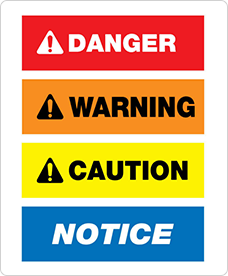ANSI Z535.6, titled “Product Safety Information in Product Manuals, Instructions, and Other Collateral Materials,” is the U.S. national standard that provides guidance on how to write and present safety messages in documentation such as product manuals, installation guides, user instructions, and marketing materials.
This article breaks down the key principles of ANSI Z535.6 with practical examples, helping technical writers and documentation managers apply the standard effectively in real-world product documentation.
Why You Should Revisit ANSI Z535.6
While many companies are aware of ANSI Z535.6, few implement it consistently or thoroughly. International standards like IEC 82079-1 and ISO 3864 offer general principles on writing user documentation and using safety symbols, but they fall short in providing specific instructions on how to phrase, structure, and place safety messages within documents.
ANSI Z535.6 fills this gap by giving clear and actionable guidance. If your manuals contain safety information, using this standard correctly isn’t just a good practice—it’s a business-critical step in protecting users and reducing liability.
Safety Information Is Not Optional—It’s a Legal Responsibility
Building a high-quality product is only part of the job. Ensuring that users can operate it safely is equally important. That’s why regulatory bodies and courts expect manufacturers to provide clear warnings and instructions.
If your documentation fails to warn users of foreseeable risks, product liability laws (such as the U.S. PL Act) may hold your company accountable. Whether a safety message was properly written and positioned can determine the outcome of a legal dispute.
Bottom line? A strong safety message strategy—backed by ANSI Z535.6—can protect your company from claims, prevent injuries, and build trust with customers.
3 Key Components of ANSI Z535.6 Every Manual Should Include
1. Signal Words: Classifying Risk Levels

Signal words convey the severity of a hazard. ANSI Z535.6 defines four types:
| Signal Word | Meaning | Color Scheme |
|---|---|---|
| DANGER | Will result in death or serious injury | Red background, white text |
| WARNING | Could result in death or serious injury | Orange background, black text |
| CAUTION | May result in minor or moderate injury | Yellow background, black text |
| NOTICE | No personal injury; property damage only | Blue or white background |
⚠️ Note: Never choose a signal word based on intuition. ANSI Z535.6 outlines criteria to evaluate the nature of the hazard and severity of the outcome. Incorrect use of signal words can confuse users or weaken your legal defense.
2. Message Panel: Writing the Body of a Safety Message
Each message should include:
- The nature of the hazard
- How to avoid it
- What happens if ignored
Example 1 – Electric Shock:
⚠ WARNING
Risk of electric shock. Disconnect power before opening the panel.
Failure to follow these instructions may result in serious injury or death.
Example 2 – Hot Surface:
⚠ CAUTION
Hot surface. Do not touch immediately after use.
Contact may cause burns.
Example 3 – Equipment Damage:
NOTICE
Do not operate the unit without the protective cover.
Doing so may result in product damage.
3. Message Placement: Where to Put Safety Information in Your Manuals
ANSI Z535.6 defines three primary formats:
Grouped Safety Messages
Place all general safety messages at the beginning of the manual in a clearly labeled section (e.g., “Important Safety Information”). This ensures that users see critical warnings before interacting with the product.
Section Safety Messages
Insert safety messages at the start of major sections like Installation, Maintenance, or Disposal. These messages highlight the risks specific to each type of task.
Embedded Safety Messages
Place safety warnings within step-by-step instructions—right at the point where the hazard is encountered.
Example:
Step 3. Remove the top cover.
⚠ CAUTION: Edges may be sharp. Wear protective gloves to avoid injury.
✅ Tip: Repeating messages across formats is not only acceptable—it’s encouraged. A critical warning can appear in the Grouped Safety section and again as an Embedded message within a procedure. Repetition reinforces awareness and reduces accidents.
Conclusion: Applying ANSI Z535.6 Is a Strategic Imperative
ANSI Z535.6 is more than a formatting guideline—it’s a safety and risk management standard. Manuals that comply with this standard do more than reduce liability: they help protect people.
At Hansem Global, we apply ANSI Z535.6 and other international standards to create documentation that is both compliant and user-focused. Our technical writers and documentation experts support global manufacturers by delivering safety-critical manuals across industries.
Need help applying ANSI Z535.6 in your documentation? Partner with us to protect your users—and your business.






